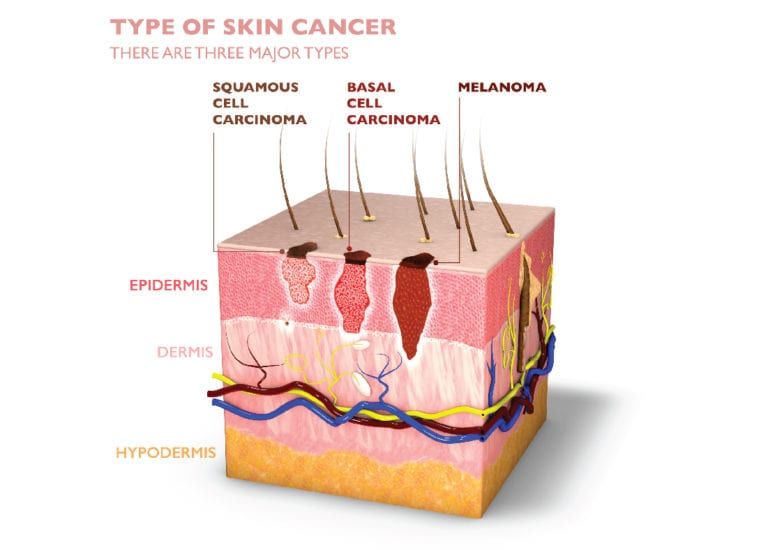Skin Cancer

SKIN CANCER is the most common of all cancer types. More than 5.4 million skin cancers are diagnosed each year in the United States.
Skin cancers often don’t cause bothersome symptoms until they have grown quite large. Then they may itch, bleed, or even hurt. But typically, they can be seen or felt long before they reach this point.
Basal cell cancers usually develop on areas exposed to the sun, especially the face, head, and neck, but they can occur anywhere on the body.
These cancers can appear as:
- Flat, firm, pale or yellow areas, similar to a scar
- Raised reddish patches that might be itchy
- Small, pink or red, translucent, shiny, pearly bumps, which might have blue, brown, or black areas
- Pink growths with raised edges and a lower area in their center, which might contain abnormal blood vessels spreading out like the spokes of a wheel
- Open sores (which may have oozing or crusted areas) that don’t heal, or that heal and then come back
Squamous cell cancers tend to occur on sun-exposed areas of the body such as the face, ear, neck, lip, and back of the hands, but they can occur anywhere on the body.
These cancers can appear as:
- Rough or scaly red patches, which might crust or bleed
- Raised growths or lumps, sometimes with a lower area in the center
- Open sores (which may have oozing or crusted areas) that don’t heal, or that heal and then come back
- Wart-like growths
“One of the things that people most often present to me with is a sore that won’t heal… Most of the time, an injury is going to heal within 4-8 weeks or so. A rule of thumb: If you have a sore that won’t heal within 8 weeks, you should see your dermatologist or your primary care provider” stated Dr. John Blake, Dermatologist at Uintah Basin Healthcare.
Melanoma is much less common than some other types of skin cancers, but melanoma is more dangerous because it’s much more likely to spread to other parts of the body if not caught and treated early.
Melanoma is a cancer that begins in the melanocytes. Melanomas can develop anywhere on the skin, but they are more likely to start on the trunk (chest and back) in men and on the legs in women. The neck and face are other common sites.
These cancers can appear as:
- Unusual moles, sores, lumps, blemishes, markings, or changes in the way an area of the skin looks or feels
It’s important to have a doctor check any new or changing skin growths, sores that don’t heal, or other areas that concern you.
Remember, most skin cancers are caused by sun exposure. DON’T FRY, prevent skin cancer. Click Here
To make an appointment in Roosevelt or Vernal with Dr. John Blake, Dermatologist @ UBH, call (435)725-2030 today.
Learn more at cancer.org

